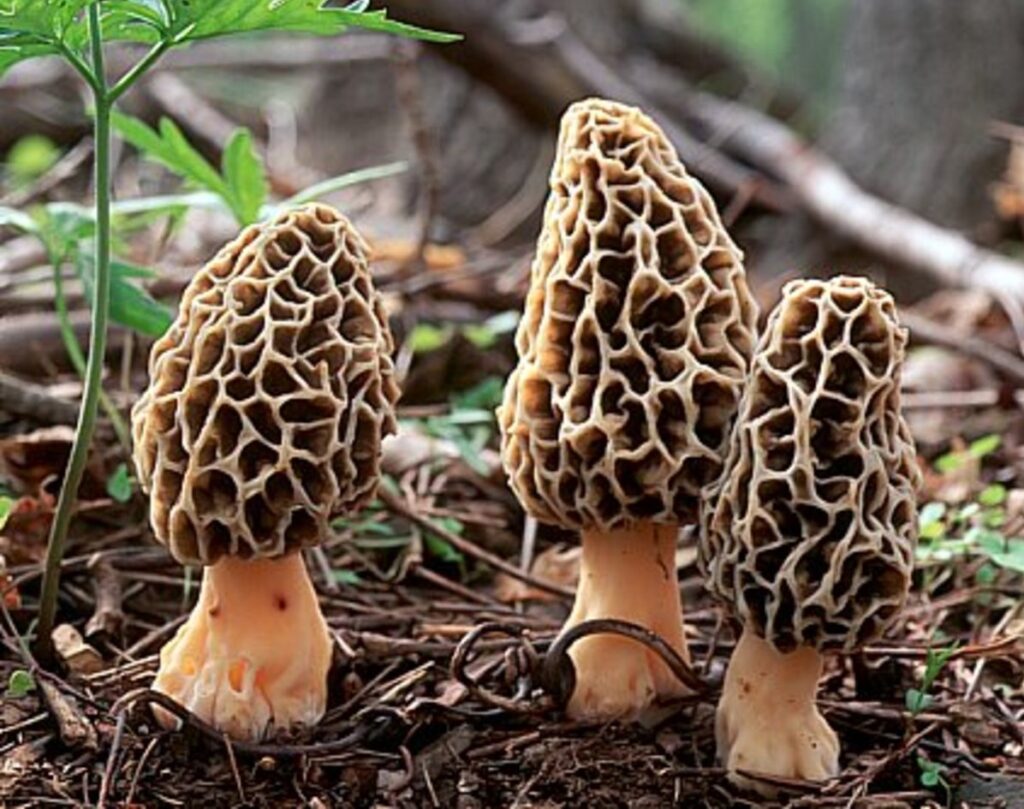
Morels are an extremely popular edible mushroom. Perhaps the most sought after of all edible mushrooms in North America. They are delicious, unique in appearance, and easy to identify for beginners. However, their season is quite short. So, while many mushroom hunters are protective of their favorite mushroom producing “hot spots”. Because of the short season, and heightened popularity of Morels. Morel hunters are much more protective of their morel patches.
The growing season for morels in the eastern US in very early spring. The first signs of green poking up through the forest floor signals hunters to take to forest. When soil temperatures reach an average of 40° F and above. Morels will begin to emerge. Like many other mushrooms, A good spring rain can signal the mycellium beneath the soil to begin sending up mushrooms. However, as soil temperatures rise further, morel season will end. It is possible to find pockets of forest where the conditions are still right for morels to fruit. But, generally speaking, after only a few short weeks the excitement. Morel season will end, and it will be time to begin foraging for other mushrooms. Luckily for us mushroom hunters there are mushrooms to be found all year long, and morels are just the beginning.
Morels in New England are a Mycorrhizal fungi. Which means, they have a mutualistic or symbiotic relationship with a particular host. In the Morels case, the host will be a type of tree. The mycellium will collect minerals and moisture from the soil, in exchange for carbohydrates and vitamins from the tree. They may also act as a bridge between the root systems of adjacent trees, providing a method of chemical communication between trees that wouldn’t exist without the presence of the fungal mycellium. We cannot see this network of mycellium underground, but over the years mycologist have learned that Morels have a tendency to associate with certain trees. So, one of the easiest ways to find a morel, is to look for a known host trees, note its location, and return to it during morel season.
Since we know that Morels live in association with trees, and mycologists have done the work of cataloging which trees they associate with. We need only look to the habitat of the trees, to understand the habitat of the Morel. Elm, Ash, Poplar, Various Fruit Trees, and Aspen are all common hosts for morel mushrooms. What all these trees have in common, is that they like well drained fertile soil. The type of soil you might find near rivers or in flood plain areas of the forest. However, fruit trees thanks to human intervention can find themselves in a variety of places, and Morels have been known to follow them.
When it comes to identifying Morels, it’s quite obvious that they don’t look like the “typical” mushroom. Morels do not have gills. Instead, the entire upper section or cap is covered in deep pits and ridges. This whole upper surface is where the spores are produced and released from. This highly textured upper section sits directly on top of, and is directly connected to, the lighter colored stem. It will not be a hollow stem, with a cap sleeved over top of it. Instead, the stem and cap will connected, and appear to be one long hollow cavity. There will also be no fuzz or filling inside the cap or stem of any kind. It will simply be relatively smooth and hollow. The odor of a morel is difficult to explain but is generally described as “pleasant”. Which depending on the nose, may be earthy, nutty, or somewhat sweet.
The taxonomy of Morels has a confusing history, and remains confusing still. However, the species in Connecticut generally fit into three different groups or clades, and the species within each clade look very similar. So, from a foragers perspective. Three different types are all you need to be able to identify. These three groups are commonly known as Black Morels, Blonde (or Yellow) Morels, and Half-Free Morels. Also, while all three types of Morels are generally easy to identify. There are some potentially toxic lookalikes. So, you should be able to distinguish the difference between a Morel and it’s potentially toxic lookalikes before you consider eating one. When in doubt, throw it out! Finally, ALWAYS cook mushrooms before eating them. Thoroughly cooking your mushrooms is considered standard practice amongst mushroom hunters. Some mushrooms, including Morels, contain toxins that will only break down when exposed to heat. Not to mention the standard protection from bacteria and parasites that cooking offers. So, the obvious choice is to neutralize those toxins, and other baddies so that we can enjoy the amazing flavor these mushrooms have to offer without any negative consequences.